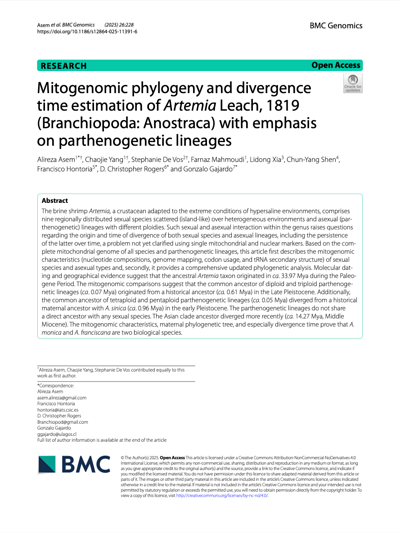Mitogenomic phylogeny and divergence time estimation of Artemia Leach, 1819 (Branchiopoda: Anostraca) with emphasis on parthenogenetic lineages
20 March 2025 | Alireza Asem, Chaojie Yang, Stephanie De Vos, Farnaz Mahmoudi, Lidong Xia, Chun‑Yang Shen , Francisco Hontoria, D. Christopher Rogers and Gonzalo Gajardo | 257 Downloads | .pdf | 6.19 MB | Biodiversity
The brine shrimp Artemia, a crustacean adapted to the extreme conditions of hypersaline environments, comprises nine regionally distributed sexual species scattered (island-like) over heterogeneous environments and asexual (parthenogenetic) lineages with different ploidies. Such sexual and asexual interaction within the genus raises questions regarding the origin and time of divergence of both sexual species and asexual lineages, including the persistence of the latter over time, a problem not yet clarified using single mitochondrial and nuclear markers. Based on the complete mitochondrial genome of all species and parthenogenetic lineages, this article first describes the mitogenomic characteristics (nucleotide compositions, genome mapping, codon usage, and tRNA secondary structure) of sexual species and asexual types and, secondly, it provides a comprehensive updated phylogenetic analysis. Molecular dating and geographical evidence suggest that the ancestral Artemia taxon originated in ca. 33.97 Mya during the Paleogene Period. The mitogenomic comparisons suggest that the common ancestor of diploid and triploid parthenogenetic lineages (ca. 0.07 Mya) originated from a historical ancestor (ca. 0.61 Mya) in the Late Pleistocene. Additionally, the common ancestor of tetraploid and pentaploid parthenogenetic lineages (ca. 0.05 Mya) diverged from a historical maternal ancestor with A. sinica (ca. 0.96 Mya) in the early Pleistocene. The parthenogenetic lineages do not share a direct ancestor with any sexual species. The Asian clade ancestor diverged more recently (ca. 14.27 Mya, Middle Miocene). The mitogenomic characteristics, maternal phylogenetic tree, and especially divergence time prove that A. monica and A. franciscana are two biological species.
Creative Commons Attribution-NonCommercial-NoDerivs.

